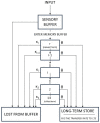Mathematical modeling of human memory
- PMID: 38187417
- PMCID: PMC10771340
- DOI: 10.3389/fpsyg.2023.1298235
Mathematical modeling of human memory
Abstract
The mathematical study of human memory is still an open challenge. Cognitive psychology and neuroscience have given a big contribution to understand how the human memory is structured and works. Cognitive psychologists developed experimental paradigms, conceived quantitative measures of performance in memory tasks for both healthy people and patients with memory disorders, but in terms of mathematical modeling human memory there is still a lot to do. There are many ways to mathematically model human memory, for example, by using mathematical analysis, linear algebra, statistics, and artificial neural networks. The aim of this study is to provide the reader with a description of some prominent models, involving mathematical analysis and linear algebra, designed to describe how memory works by predicting the results of psychological experiments. We have ordered the models from a chronological point of view and, for each model, we have emphasized what are, in our opinion, the strong and weak points. We are aware that this study covers just a part of human memory modeling as well as that we have made a personal selection, which is arguable. Nevertheless, our hope is to help scientists to modeling human memory and its diseases.
Keywords: amnesia; demantia; mathematics; memory; models; neuropsychology.
Copyright © 2023 Finotelli and Eustache.
Conflict of interest statement
The authors declare that the research was conducted in the absence of any commercial or financial relationships that could be construed as a potential conflict of interest.
Figures


Similar articles
-
Learning and solving algebra word problems: The roles of relational skills, arithmetic, and executive functioning.Dev Psychol. 2018 Sep;54(9):1758-1772. doi: 10.1037/dev0000561. Dev Psychol. 2018. PMID: 30148402
-
Higher level domain specific skills in mathematics; The relationship between algebra, geometry, executive function skills and mathematics achievement.PLoS One. 2023 Nov 6;18(11):e0291796. doi: 10.1371/journal.pone.0291796. eCollection 2023. PLoS One. 2023. PMID: 37931003 Free PMC article.
-
Mathematical psychology.Wiley Interdiscip Rev Cogn Sci. 2010 Sep;1(5):759-765. doi: 10.1002/wcs.46. Epub 2010 Jun 30. Wiley Interdiscip Rev Cogn Sci. 2010. PMID: 26271659
-
The developmental origins of naïve psychology in infancy.Adv Child Dev Behav. 2009;37:55-104. doi: 10.1016/s0065-2407(09)03702-1. Adv Child Dev Behav. 2009. PMID: 19673160 Review.
-
[Effects of cognitive aging on memory performances].Presse Med. 2000 Apr 22-29;29(15):849-57. Presse Med. 2000. PMID: 10827794 Review. French.
References
-
- Anderson J. (1970). Two models for memory organization using interacting traces. Math. Biosci. 8, 137–160. 10.1016/0025-5564(70)90147-1 - DOI
-
- Anderson O. (1983). A neuromathematical model of human information processing and its application to science content acquisition. J. Res. Sci. Teach. 20, 603–620. 10.1002/tea.3660200702 - DOI
-
- Anderson O. R. (1986). Studies on information processing rates in science learning and related cognitive variables. I: Some theoretical issues related to motivation. J. Res. Sci. Teach. 23, 61–66. 10.1002/tea.3660230107 - DOI
Publication types
LinkOut - more resources
Full Text Sources

